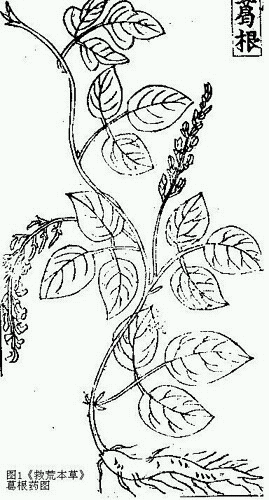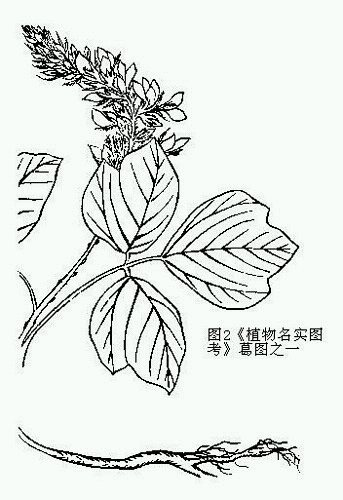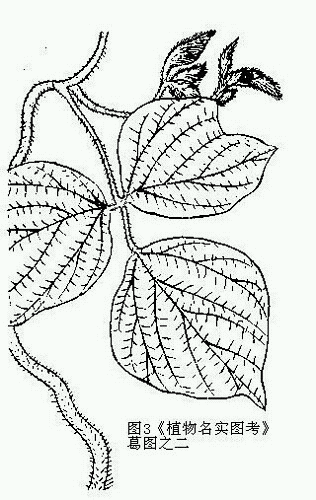| title | Pueraria Root, Edible Kudzuvine Root |
| release time | 2006/7/7 |
| source | Jade Knock Studio |
| keyword | Pueraria Root Edible Kudzuvine Root |
Pueraria Root is the dried root of Pueraria lobata (Willd.) Ohwi, a plant of the legume family, while edible kudzuvine root is the dried root of Pueraria thomsonii Benth., also a plant of the legume family. The former is commonly known as "wild kudzu," and the latter as "edible kudzuvine root." Wild kudzu is widely distributed across the country, mainly produced in Hunan, Henan, Guangdong, Zhejiang, and Sichuan; edible kudzuvine root is mostly cultivated, mainly produced in Guangxi and Guangdong, and also in Sichuan and Yunnan.
Materia medica research suggests that medicinal Pueraria Root mainly comes from plants of the Pueraria genus in the legume family. Historical literature has consistently regarded Pueraria lobata as the authentic source, while Pueraria thomsonii is primarily used for making kudzu powder. Although it can also be used as Pueraria Root, it is considered to be of inferior quality compared to the former. According to the 2005 edition of the Chinese Pharmacopoeia, Pueraria lobata has become the sole source of medicinal Pueraria Root, meaning that Pueraria thomsonii will eventually lose its medicinal status, except for its use as food. Pueraria Root does not have a distinct regional specificity, and cultivation can be adapted according to local conditions.
bubble_chart Varietal Examination
In ancient times, kudzu was an economic crop. The "Book of Songs" frequently uses kudzu as a metaphor, such as "She gathers kudzu," "The kudzu on the mound," and "The tangled kudzu shoes." The fibers of kudzu could be spun into cloth, and its roots and leaves were used for food. The "Book of Zhou" states: "The common people use its leaves for soup, while the noblemen use its material for fine and coarse cloth, making summer clothing for the court." The "Rites of Zhou" mentions an official in charge of kudzu: "He is responsible for collecting materials for fine and coarse cloth from mountain farmers at the appropriate time." The "Book of Songs, Zhou Nan, Ge Tan" says: "The kudzu spreads, extending to the valley, its leaves lush. It is cut and boiled, made into fine and coarse cloth, and worn without weariness." It does not specify whether the kudzu was cultivated or wild. The "Book of Songs, Tang Feng, Ge Sheng" states: "The kudzu grows over the brambles, spreading across the wild," and the "Garden of Stories" quotes a poem: "The continuous kudzu lies in the wilderness. A skilled craftsman can turn it into fine and coarse cloth. Without a skilled craftsman, it withers and dies in the wild." This suggests that kudzu was mainly wild. Additionally, the "Yue Jue Shu" mentions: "Gou Jian planted kudzu and had the women of Yue weave kudzu cloth to present to Fu Chai." This indicates that kudzu was also cultivated in the Wu and Yue regions at that time. However, after the Han dynasty, with the maturation of cotton and hemp fiber crops and rice and wheat grain crops, the value of kudzu gradually declined. Therefore, from the "Qi Min Yao Shu" onwards, various agricultural texts almost never specifically mention the cultivation of kudzu.
Ge mainly uses its roots for medicinal purposes, listed as a middle-grade herb in the Bencao Jing. The species used throughout history are complex, mostly belonging to the legume genus Pueraria. Tao Hong-jing had already noted the differences between edible and medicinal varieties of Pueraria Root. The "Ji Zhu" states: "The Pueraria Root of today is commonly steamed and eaten. One should select those with deep and large roots, break them and dry them in the sun. The raw roots can be mashed to extract juice for drinking, which alleviates warm disease fever. The flowers, along with small bean flowers, dried and powdered, taken in a square-cun spoon, make one drink without getting drunk. The best quality comes from Nankang and Luling, being fleshy with few fibers, sweet and delicious, but for medicinal use, it is deficient here." Although there is no record of plant characteristics, the general idea is that the Pueraria Root from Nankang and Luling in Jiangxi is sweet and suitable for eating. "Here" likely refers to Tao Hong-jing's location at Maoshan, where it is excellent for medicinal use but not ideal for eating. According to studies, the root of wild kudzu (Pueraria lobata) can contain up to 12% flavonoids, has a bean-like odor, and a poor taste, while the root of Pueraria thomsonii contains much lower levels of flavonoids, generally around 2%. As for the edible kudzu (Pueraria edulis Pamp.), the content can be as low as 1%. Therefore, Pueraria lobata should indeed be the mainstream for medicinal Pueraria Root.Bencao Tujing describes Pueraria Root: "Nowadays, it can be found everywhere, especially in Jiangsu and Zhejiang. It sprouts in spring, with vines extending one to two zhang, purple in color, and leaves somewhat resembling those of the Catalpa tree but greener. It blooms in July with flowers similar to pea flowers, but does not bear fruit. The root is as large as an arm, purple-black in color. The root is best harvested at noon on the fifth day of the fifth month and then dried in the sun. The deeper the root grows into the soil, the better its quality. Nowadays, many people make flour from it, which is very beneficial. There is an entry for kudzu flour in the lower grade, referring to this." This text mistakenly states that kudzu "does not bear fruit," which has been criticized by Gangmu, but the rest of the description is generally consistent with the Pueraria genus today. "Zhenglei" illustrates Pueraria Root from Chengzhou and Haizhou. The Pueraria Root from Chengzhou has single leaves, which is distinctly different from the trifoliate leaves of the Pueraria genus, while the Pueraria Root from Haizhou has trifoliate leaves, obvious pods, and tuberous roots, clearly belonging to the Pueraria genus. However, whether it is Pueraria lobata is uncertain.
Li Shi-zhen pointed out the differences between wild and cultivated varieties of kudzu. Bencao Gangmu, Volume 18 states: "Kudzu can be wild or cultivated. Its vines are long and can be used to make coarse and fine cloth. The root is purple on the outside and white inside, with the longest reaching seven to eight chi. The leaves have three points, resembling maple leaves but longer, green on the surface and pale on the back. The flowers form spikes, densely clustered, red-purple in color. The pods resemble small soybean pods and are also hairy. The seeds are green, flat like the kernels of salted plum seeds, and have a bean-like smell when chewed raw. They are harvested in August and September, which is what Benjing refers to as 'Ge Gu.' Tang Su Gong also mentioned that 'Ge Gu' refers to the fruit, while Song Su Song mistakenly stated that Pueraria flowers do not bear fruit." According to this description, it is Pueraria lobata. Additionally, the Pueraria Root illustration in Jiuhuang Bencao also resembles this species. (Figure 1) Zhiwu Mingshi Tukao also mentions that kudzu has "both cultivated and wild varieties," with two illustrations, one resembling Pueraria lobata and the other resembling Pueraria thomsonii. (Figures 2 and 3)


There are three points to discuss regarding Pueraria Root.
(1) Edible kudzuvine root and kudzu flour
Although both wild kudzu (Pueraria lobata) and sweet kudzu (Pueraria thomsonii) were used as Pueraria Root in ancient times, most literature considers wild kudzu superior to cultivated varieties, often specifying wild kudzu as the standard Pueraria Root. When sweet kudzu was required, prescriptions would specify "edible kudzuvine root" to distinguish it, such as in Renzhai Zhizhi, Volume 17, where loquat leaf powder uses one qian of edible kudzuvine root, with a note stating "cultivated varieties are better."
Pueraria Root can be processed into kudzu flour, with sweet kudzu generally preferred for its high starch content. Bencao Yanyi describes the method of making kudzu flour: "In winter, take raw kudzu, knead it in water to extract the flour, and let it settle into blocks. First boil water until it boils, then break the blocks into pieces and add them to the boiling water. After a while, the color becomes like glue, and the texture is very tough. Mix it with honey water and eat it, adding a little fresh ginger rhizome for better taste. It is highly effective for treating internal heat and alcohol-induced thirst. Consuming more promotes urination and can also cause diarrhea. It is very beneficial for those suffering from alcohol-related illnesses or thirst. Some people also slice it and add it to tea for guests, but it is sweet and not particularly beneficial." Although kudzu flour can also be used medicinally, as recorded in "Kaibao" for its efficacy, it is more commonly consumed as food. Bai Juyi's poem "Inviting Monk Taoguang" includes the lines: "In a humble house, fragrant rice is cooked, without meat or fish. Filtered water clarifies kudzu flour, and hands pick vine flowers." "Zunsheng Bajian" records the food therapy value of kudzu flour: "It stimulates appetite and quenches thirst."The 2005 edition of the Chinese Pharmacopoeia officially stipulates that the source of Pueraria Root is Pueraria lobata, excluding Pueraria thomsonii. This regulation seems reasonable both from the perspective of literature and modern component research. In the future, if Pueraria thomsonii cannot make new discoveries in terms of components and medicinal efficacy, it is highly likely to be phased out from the medicinal material market. As for its edible value, it may be further developed.
(2) Wild Kudzu and Toxic Kudzu
Modern botanists have determined the Chinese name of Pueraria lobata as "wild kudzu," which seems inappropriate. "Wild kudzu" or "toxic kudzu" has always been regarded as a synonym for poisonous plants. For example, in "Huainanzi: Shuo Lin Xun," it is stated, "If a viper bites a person, applying hejin will cure it." Gao You's annotation: "Hejin, wild kudzu, a poisonous herb." "Lunheng: Yan Du" states: "Among plants, there are Croton Fruit and wild kudzu; consuming them causes discomfort and often kills people." "Zhouyi Cantongqi" states: "One liang of toxic kudzu or Croton Fruit in the throat, even if King Wen divines with yarrow, Confucius interprets the hexagrams, Bian Que wields the needle, and Wuxian beats the drum, cannot revive the person." According to "Bencao Jing," wild kudzu is an alias for Gelsemium elegans, the most toxic plant. "Wu Pu Materia Medica" states: "Qin Gelsemium, also known as poisonous root or wild kudzu. Shennong says it is pungent, Leigong says it is toxic and kills. It grows in the mountains of Nanyue or Yizhou. Its leaves resemble kudzu, with red stems as thick as arrows and yellow square roots. It may grow in Dongye, Kuaiji, and is harvested in the first month." According to this, this Gelsemium is called wild kudzu because its leaves resemble kudzu.
Further examination of "Mengxi Bitan" states: "I once had someone dig up a plant to observe it. The plant creeps like kudzu, with red vines and thick joints resembling crane knees. The leaves are round with pointed tips, resembling apricot leaves but thicker and glossy, like persimmon leaves. Three leaves form a branch, similar to mung beans, with leaves growing between the joints, opposite each other. The flowers are small and yellow, clustered like fennel flowers, growing between the joints and leaves. 'Youyang Zazu' mistakenly states that the flowers resemble gardenia, slightly larger. The root bark is also red. Fujian people call it hook mang, also known as wild kudzu. Lingnan people call it hu man, commonly known as graceful jessamine herb." According to this description, this wild kudzu Gelsemium, with leaves resembling kudzu, should be Toxicodendron radicans (L.) O. Kuntze ssp. Hispidum (Engl.) Gillis, a climbing shrub whose toxins mainly cause skin and mucous membrane reactions, and can be fatal in severe cases.
As for Shen Kuo's statement: "(Wild kudzu) is extremely toxic and not used in medicine. I fear that the materia medica refers to something else, not this Gelsemium. I have seen 'Qianjin' and 'Waitai Miyao' prescriptions occasionally using wild kudzu, so one must be very careful and not use it by name." This is incorrect. A careful analysis of all prescriptions mentioning wild kudzu in "Qianjin" shows no relation to the leguminous Pueraria Root. "Zhenglei Bencao" specifically uses wild kudzu for ghostly infestations, early abortion, and poisoning, indicating it is not Pueraria Root.
Therefore, it is more appropriate to call Pueraria lobata "kudzu" or "kudzu vine" to avoid confusion with the toxic "wild kudzu."
(3) Sweet Kudzu and Bitter Kudzu
"Diannan Bencao" entry on Pueraria Root states: "The sweet-tasting one is sweet kudzu, the bitter-tasting one is bitter kudzu." The Qing "Guizhou Tongzhi" volume 15 records the produce of Nanlong Prefecture, mentioning edible kudzu root: "Edible kudzu root spreads widely across the fields; the roots can be used to make powder, and the flowers can relieve hangovers. There are sweet and bitter varieties." The compilers of "Diannan Bencao" identified the sweet kudzu as Pueraria edulis and the bitter kudzu as Pueraria peduncularis Grah., which is a plausible theory.
bubble_chart Historical Evolution of Authentic Sources
Although the Bencao Jing states that Pueraria Root "grows in the valleys of Wenshan," in fact, Pueraria plants, whether cultivated or wild, are widely distributed and do not have a strong regional specificity. The "New Book of Tang: Geography" records that the prefectures and commanderies that offered tribute of kudzu powder included Yuezhou Huiji Commandery, Wuzhou Dongyang Commandery, Xinzhou, Meizhou Tongyi Commandery, Jianzhou Puan Commandery, and Longzhou Yingling Commandery. The Bencao Tujing mentions that "now it is found everywhere, especially in Jiangsu and Zhejiang." The "Pin Hui Jing Yao" considers Jiangsu, Zhejiang, Nankang, and Luling as the authentic regions. The "Zhiwu Mingshi Tukao" states: "Kudzu is both cultivated in gardens and found in the wild," and also mentions that "now it is highly valued in Lingnan, and is also rare in Wu and Yue. Whether in Yan, Yu, Jiangxi, or Huguang, kudzu is produced." The "Hua Jing" says: "Only that from Guangdong is the best." In summary, Pueraria Root does not have a distinct regional specificity, and cultivation can be carried out according to the suitability of the production areas.
bubble_chart Other Related Items




